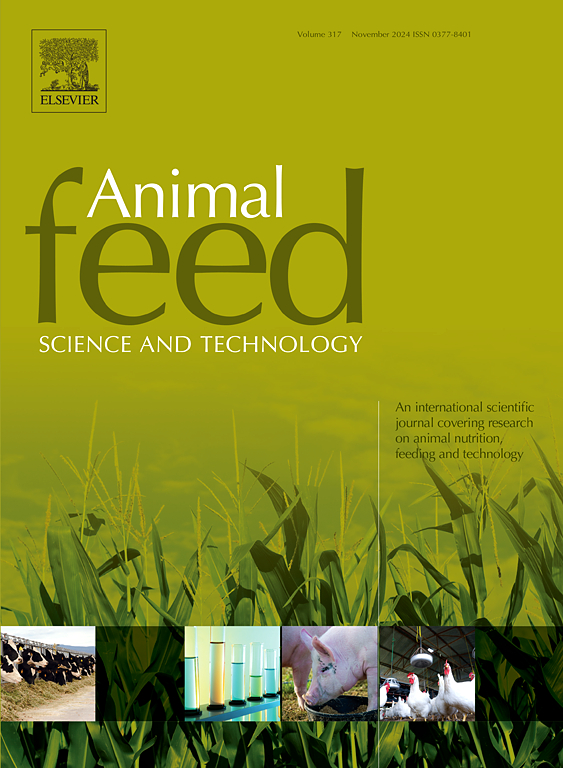Effectiveness of combining Lentilactobacillus buchneri, Lentilactobacillus hilgardii, and lemongrass essential oil in rehydrated corn silage preservation
IF 2.7
2区 农林科学
Q1 AGRICULTURE, DAIRY & ANIMAL SCIENCE
引用次数: 0
Abstract
Heterofermentative lactic acid bacteria and essential oils have been investigated as strategies to control undesirable microorganisms in silages. This study evaluated the effects of Lentilactobacillus buchneri and Lentilactobacillus hilgardii inoculation (INO) and lemongrass essential oil (LEO) addition on fermentation profile and losses, chemical composition, in vitro degradation, and aerobic stability of rehydrated corn silage (RCS). Thirty-two experimental silos were arranged in a randomized block design to evaluate four treatments in a 2 × 2 arrangement, assessing the following factors: I. Microbial inoculation: -INO: without inoculation or +INO: containing 300,000 colony-forming units (CFU)/g of L. buchneri NCIMB 40788 and 300,000 CFU/g of L. hilgardii CNCM I-4785; and II. lemongrass essential oil: -EO: no essential oil or +EO: 2 mL/kg LEO on an as-fed basis. No interaction was observed between INO and EO. Inoculation increased silage pH and acetic acid, while reducing lactic acid from 79.5 to 24.8 g/kg. In contrast, EO had no effect on the fermentation profile. INO also increased fermentation losses and reduced DM recovery. Additionally, inoculation decreased dry matter and neutral detergent fiber content, whereas EO slightly increased organic matter. After aerobic exposure, +INO exhibited higher silage pH without affecting temperature. Thus, the combination of L. buchneri and L. hilgardii with lemongrass essential oil does not provide synergistic benefits for the preservation of rehydrated corn silage.
布氏慢乳杆菌、希勒盖慢乳杆菌和柠檬草精油在复水玉米青贮保鲜中的效果
研究了异发酵乳酸菌和精油作为控制青贮中有害微生物的策略。研究了接种布氏慢乳杆菌(Lentilactobacillus buchneri)和hilgardii慢乳杆菌(Lentilactobacillus hilgardii)和添加柠檬草精油(LEO)对复水合玉米青贮(RCS)发酵特性、损失、化学组成、体外降解和有氧稳定性的影响。试验采用随机区组设计,采用2 × 2的设计方式,对4个处理进行评价,评估如下因素:1 .微生物接种:-INO:不接种;+INO:含30万CFU/g布氏乳杆菌NCIMB 40788和30万CFU/g希尔加底乳杆菌CNCM I-4785;和二世。柠檬草精油:-EO:不含精油或+EO: 2 mL/kg LEO。INO和EO之间没有相互作用。接种使青贮pH和乙酸增加,乳酸从79.5 g/kg降至24.8 g/kg。相反,EO对发酵曲线没有影响。INO还增加了发酵损失,降低了DM回收率。此外,接种降低了干物质和中性洗涤纤维含量,而EO略微增加了有机质含量。有氧暴露后,+INO在不影响温度的情况下表现出更高的青贮pH值。因此,布氏乳杆菌和希尔加德乳杆菌与柠檬草精油组合使用对复水玉米青贮的保鲜不具有协同效应。
本文章由计算机程序翻译,如有差异,请以英文原文为准。
求助全文
约1分钟内获得全文
求助全文
来源期刊

Animal Feed Science and Technology
农林科学-奶制品与动物科学
CiteScore
6.00
自引率
6.20%
发文量
266
审稿时长
3 months
期刊介绍:
Animal Feed Science and Technology is a unique journal publishing scientific papers of international interest focusing on animal feeds and their feeding.
Papers describing research on feed for ruminants and non-ruminants, including poultry, horses, companion animals and aquatic animals, are welcome.
The journal covers the following areas:
Nutritive value of feeds (e.g., assessment, improvement)
Methods of conserving and processing feeds that affect their nutritional value
Agronomic and climatic factors influencing the nutritive value of feeds
Utilization of feeds and the improvement of such
Metabolic, production, reproduction and health responses, as well as potential environmental impacts, of diet inputs and feed technologies (e.g., feeds, feed additives, feed components, mycotoxins)
Mathematical models relating directly to animal-feed interactions
Analytical and experimental methods for feed evaluation
Environmental impacts of feed technologies in animal production.
 求助内容:
求助内容: 应助结果提醒方式:
应助结果提醒方式:


